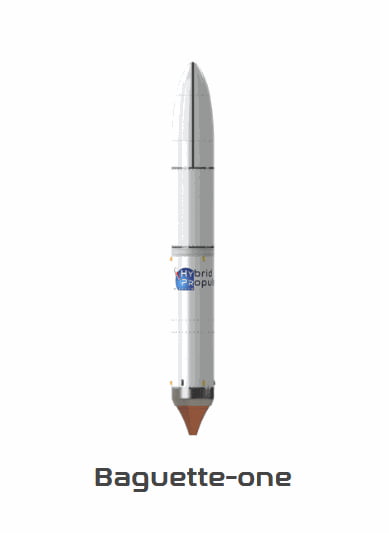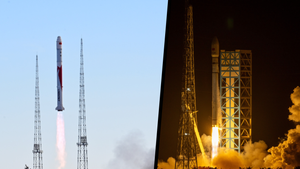
Mar 30, 2024
HyPrSpace - A New Chapter in French Aerospace Innovation
HyPrSpace is in the process of creating a novel orbital hybrid micro-launcher, poised to revolutionize space launch operations with its reusability, environmental friendliness, and cost-effectiveness compared to conventional launch systems. Their recent success in securing the France 2030 project bid and securing nearly 1.5 million euros in seed funding marks a significant milestone for the company.
This strategic collaboration with Beyond Gravity, formerly known as RUAG Space, presents a remarkable opportunity for the burgeoning French startup. Beyond Gravity, an esteemed international player in the aerospace industry, boasting over four decades of expertise in composite materials and separation systems, brings invaluable knowledge and resources to the table. Through this partnership, HyPrSpace stands to benefit significantly from Beyond Gravity's proficiency in designing and producing structural composite components using their cutting-edge FlexLine technology platform. This collaboration is poised to propel the development of HyPrSpace's OB-1 micro-launcher, fostering innovation and expediting its journey towards realization.
Before OB-1 however, HyPrSpace plans on developing their Baguette-1 rocket which will help prove key technologies for HyPrSpace's fleet.

Baguette one is a suborbital rocket that uses a hybrid rocket engine with an aerospike nozzle. It plans on sending a maximum payload of 300kg on a suborbital trajectory. Just like Electron vs Neutron and Falcon 1 vs Falcon 9, every company must start somewhere to truly hone in and develop the skills required for their goals.
What is a Hybrid Rocket Engine? What makes HyPrSpace unique?
Hybrid rocket technology represents an intriguing frontier in propulsion systems, blending elements of both solid and liquid propellants. Unlike conventional solid or liquid rockets, hybrids employ a unique combination of fuel and oxidizer states. Typically, a solid fuel is paired with a liquid or gaseous oxidizer, creating a versatile and potentially safer propulsion solution.
As HyPrSpace puts it
"Hybrid Rocket Engine exists since the dawn of aerospace industry. The problem is: it does not scale. And that’s where we came in: we find a way to make it scalable. Basically, what we did is start hybrid rocket engine design from scratch and ended up completely modifying the whole engine architecture. What used to be technologically locked in 60 years of research is now feasible: scaling HRE to the size of the vehicle it powers. With great opportunities just ahead of us!"
Their first suborbital flights will be from a French Space Force base. From there they will likely move to orbital launches from Esrange in Sweden and from Guiana - as a French company there likely to get the go-ahead from CNES. After that, their ultimate goal is sea launch. They plan to be able to pull up a launch platform close to a customer, integrate the payload, and then launch.
Challenges in Hybrid Rocket Technology
Despite its promise, hybrid rocket technology presents several challenges. One significant obstacle lies in optimizing the combustion process. Achieving efficient fuel burning rates while maintaining stable combustion is essential for performance and reliability. Additionally, the compatibility of different fuel and oxidizer combinations must be carefully evaluated to prevent undesirable reactions or instability.
The genesis of hybrid rockets traces back to the early 1930s, with pioneering research conducted by the Soviet Group for the Study of Reactive Motion. Notably, Mikhail Klavdievich Tikhonravov, a prominent figure who later oversaw the design of groundbreaking space missions such as Sputnik I and the Luna programme, spearheaded the first hybrid-propelled rocket launch, known as the GIRD-9, on 17 August 1933. Despite reaching a modest altitude of 400 meters (1,300 feet), this achievement marked a pivotal moment in the exploration of hybrid propulsion technology.
Parallel advancements unfolded in Germany at IG Farben and simultaneously in the United States at the California Rocket Society during the late 1930s. Within this context, Leonid Andrussow, working in Germany, contributed significant theoretical insights into hybrid propellant rockets. Collaborators such as O. Lutz, W. Noeggerath, and Andrussow conducted experiments involving a 10-kilonewton (2,200 lbf) hybrid rocket motor, utilizing coal and gaseous N2O as propellants. Concurrently, visionary minds like Oberth explored the potential of hybrid rocket motors employing LOX as the oxidizer and graphite as the fuel.
However, despite these early strides, challenges emerged, particularly regarding the efficient operation of hybrid rocket motors. The high heat of sublimation of carbon posed a significant obstacle, leading to negligible burning rates and hampering overall efficiency. Nevertheless, these historical endeavors serve as valuable lessons, offering insights into the complexities and potential pitfalls associated with hybrid rocket technology. In the modern era, with advancements in materials science, propulsion systems, and computational modeling, there exists a renewed opportunity to build upon these foundational learnings and unlock the full potential of hybrid propulsion for future space exploration endeavors.
Aerospikes? What are they and what do they offer?
Aerospike engines represent an innovative approach to rocket propulsion, offering potential improvements in efficiency and performance over traditional bell-shaped rocket nozzles. Unlike conventional engines, which utilize a fixed nozzle design, aerospike engines feature a unique geometric configuration that adapts to varying atmospheric pressures during flight.
The central component of an aerospike engine is the "spike," which protrudes from the center of the engine's exhaust chamber. This spike interacts with the surrounding airflow, forming a virtual bell-shaped nozzle. As the atmospheric pressure changes with altitude, the shape of the exhaust plume adjusts accordingly, optimizing thrust efficiency across a broader range of operating conditions. This allows for the rocket to be efficient at various altitudes and meaning that the Baguette rockets can soar far into the skies!
What does the future of HyPrSpace look like?

Looking at more recent graphics like this from HyPrSpace it appears that they might be focusing on more realistic architectures, planning on possibly scrapping the Aerospike engine for a more traditional bell. HyPrSpace appears to be adaptable to changing landscapes, with talk of possible orbital rockets being reusable the future of HyPrSpace is still hard to define.
What is known is that HyPrSpace appears to be a serious player in a developmental stage and one who you should have a close eye on. The company's future prospects include the launch of microsatellites, keeping constellations in operational condition by replacing faulty satellites, enabling private customers like telecoms, satellite data providers, and public customers like governments, laboratories, and universities to help with a responsive launch service at a competitive price.
HyPrSpace in collaboration with several other firms aims on developing itself by leveraging key players within the industry and creating a cheap, eco friendly alternative to space. In December of 2023 they received funding. The firms said in a statement after receiving funding,
"This disruptive innovation in space propulsion will permit cheaper access to space that better respects the environment"
Here's to the future of the French aerospace industry! Good luck to CNES, and Good luck to HyPrSpace and all associated firms in sending "Baguettes" to the frontier of space!



